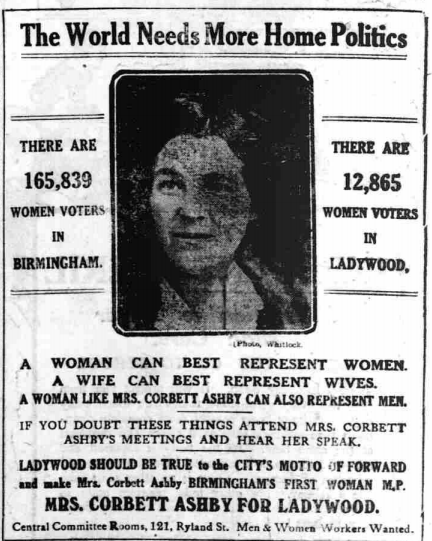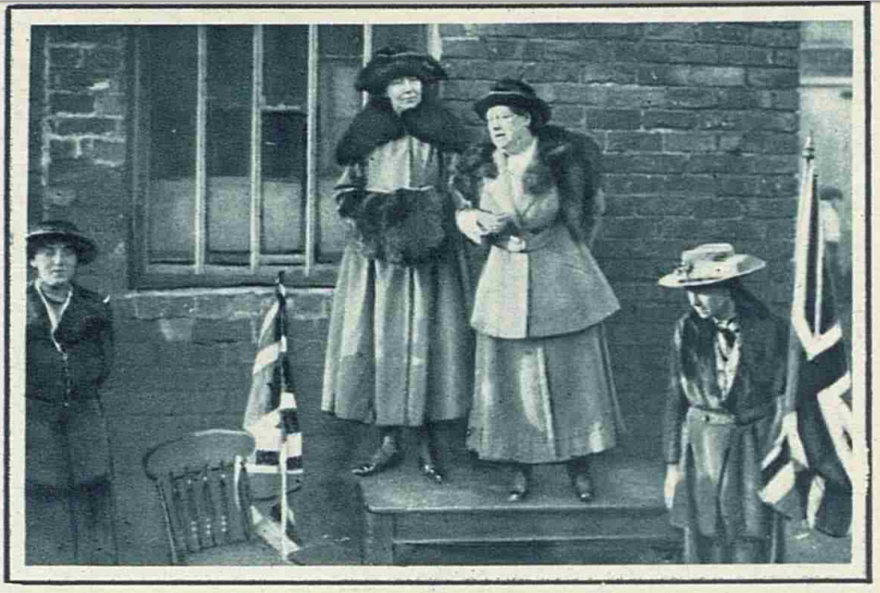Anna Muggeridge, A PhD student from the University of Worcester, investigates 100 years since the first female vote in Birmingham.
100 years ago, on 14 December 1918, women in Britain went to the polls to vote in a General Election for the first time. Just ten months after the Representation of the People Act had awarded voting to some women (those over thirty, who met a property qualification), the newly-expanded electorate cast their first ballots.
As part of my doctoral research, I have been investigating how women in and around Birmingham reacted to their new ability to vote. In this election, the city and surrounding districts saw three women stand as parliamentary candidates: Margery Corbett Ashby, Liberal candidate for Birmingham Ladywood; Christabel Pankhurst, Women’s Party candidate for Smethwick, and Mary Macarthur, Labour candidate for nearby Stourbridge, although none were successful. The prospect of potentially being able to vote for one of these three women, who were among the first to stand nationwide, does seem to have excited some local women, but others remained distinctly unenthused.
Several Birmingham newspapers, including the Birmingham Mail, reported on 15 December 1918 that a Mrs Fanny Vince claimed to be the first woman in Birmingham to vote: at 7am, she had been found outside her polling station, waiting for it to open. But the Birmingham Mail also recorded that an unnamed ‘old lady’, who, when asked whether she had voted, responded: ‘Well, my dear, I never have voted and I ain’t goin’ to start now at my time o’ life.’

These two opposing reactions to the prospect of voting for the first time neatly reflect national trends in this election. Whilst some women, particularly those who had been involved with the suffrage movement, were undoubtedly delighted by the prospect of finally having the vote, nationwide turnout was very low, at only 57%.
A gendered breakdown of the turnout statistics are not available, so it is not possible to know what percentage of women did not vote, or why they chose not to exercise their newfound powers. By studying local newspapers, however, it is possible to gain an understanding of how these new women voters were perceived by the press, and what fears surrounded the prospect of a female electorate.
The election results would not be known for another two weeks, as servicemen’s ballots would need to be sent from overseas. This did not stop speculation, and in Birmingham, local newspapers sent reporters out to various parts of the city to report on how women were behaving at the polling stations.
The Birmingham Mail reported that, ‘in residential districts, such as Edgbaston and Moseley, the number of women going to the polls was relatively large; in fact, much larger than had been anticipated’. However, ‘in some working-class districts—of which Aston may be quoted as an example—the number of women voters in the early hours of polling was low. A prominent worker declared that during his circuit of one electoral area, he had not seen one woman voter. In a thickly populated area at Nechells [another very working-class district] only six votes were recorded in the first two hours.’ Edgbaston and Mosley were then among the wealthiest areas of Birmingham, and the women living there, if they were over 30, were highly likely to have met the property qualifications in the 1918 Act, so it is perhaps unsurprising that polling stations in the districts were filled with women. In contrast, women in poorer areas were perhaps less likely to meet these property qualifications and were therefore more likely to be still excluded from the franchise, meaning fewer women would be visible at the polls.
However, this distinction seems not to have been understood at the time. Instead, the press framed the lower numbers in working-class areas as laziness on the part of working-class women. In working-class Duddeston, the Birmingham Mail reported that, ‘Some women refused to vote at all unless they were accompanied by their husbands. They had literally to be pushed into the polling stations’. The Birmingham Gazette meanwhile reported that, ‘While in the better class districts the women polled better and earlier than expected, in the congested working-class areas the women seemed more or less indifferent, many of them refusing, in spite of entreaties to walk short distances to the polling booths’. The complicated rules surrounding women’s enfranchisement, and its impact on voter turnout were bypassed in favour of a simplistic narrative which portrayed working-class women as lazy, and, where they could be bothered to vote, in need of male guidance—which perhaps says something more about contemporary worries about the newly expanded electorate than it does about women’s own experiences at the polls.

The 1918 Representation of the People Act gave the vote to almost all men, along with about 8 million women who met its requirements; in so doing, it essentially tripled the electorate.
It is perhaps unsurprising that there was concern over the impact of this enormous expansion, and uncertainty over how the newly-enfranchised would vote. Nonetheless, it is striking that the newspapers, at least in Birmingham, focused their anxieties solely on the newly-enfranchised women, and not their far more numerous male counterparts.
The History BA at the University of Worcester investigates women's place in history and the changes that have occurred through time.
Anna Muggeridge is a doctoral student at the University of Worcester, researching how women in the Black Country were politicised in the first half of the twentieth century. She is on Twitter @annamuggeridge and would love to hear more stories about women voters in 1918.
Image credits
(Picture: ‘Corbett Ashby campaign poster’. Copyright caption: ‘Birmingham Daily Gazette, 3 December 1918, p. 5. Image © Trinity Mirror. Image created courtesy of THE BRITISH LIBRARY BOARD’)
(Picture: ‘Pankhurst campaigning’. Copyright caption: ‘‘Topics of the Time’, The Sketch, 11 December 1918, p. 320. Image © Illustrated London News Group. Image © THE BRITISH LIBRARY BOARD’.)
All views expressed in this blog are the Academic’s own and do not represent the views, policies or opinions of the University of Worcester or any of its partners.